


Is the mean greater than, less than, or about the same as the median? Is the lower quartile closer to the median, farther from the median, or about the same distance from the median as the upper quartile? Would you describe the distribution of the percentage of African-Americanresidents in the 50 states as symmetric or skewed? Find the mean, median, lower quartile, and upper quartile. Also make sure, as always,that your graph is appropriately labeled. This keeps the lowest bar fromextending below zero, as negative values for this variable do not make sense. As always, it is a good idea to select the "Cutpoint" interval type. Remember you can change the number of bars by double clicking insideone of the bars and selecting the "Binning" tab. Examine (and present) a histogram of the variable "AfAm".

For example, you could check interquartile range if you don't want to figure it out by subtracting the lower quartile from the upper quartile, and you could uncheck things like SE of mean which we haven't learned about yet, or the number of observations, which we know is 50. Then you can check whatever variables you want to see. If you want to look at a different set of summary statistics than the default ones, click on "Statistics" before clicking "OK". Then double click on "Poverty" to choose it as the Variable, and leave the Group variable box blank. In Minitab Express, you go to Statistics -> Summary Statistics -> Descriptive Statistics.

Also, the lower and upper quartiles are 10.875 and 16.85 percent respectively.Take a look at a histogram of the poverty rates (remember you can go to Graph -> Histogram),and you should see that about half of the states' poverty rates fall within this range. You should see, for example that the mean poverty rate for the 50 statesis 13.966 percent, while the standard deviation is 3.879 percent. Go to Stat -> Basic Statistics -> Display Descriptive Statistics.Double click on the Poverty variable on the left, then click "OK". First practice with the Poverty variable.
#Calculate pearson's r minitab express how to
In this lab, you will learn how to use Minitab to obtain numerical as well asgraphical summaries of data. In Lab 1, you learned how to summarize data graphically. The other variables came from the State Health Facts web site provided by the Kaiser Foundation. The variable Poverty came from WorldAtlas. The variables AfAm, AsAm, and Hispanic came from the U.S. Percentage of people in the state in 2014 of Hispanic or Latino origin Percentage of people in the state in 2014 who were Asian-American Percentage of people in the state in 2014 who were African-American Percentage of adults who reported participating in some physical activity or exercise during the past month in 2014Īge adjusted death rate per 100,000 people from heart disease in 2013 Percentage of people over age 18 who smoked in 2014 Percentage of live births under 2500 grams in 2013 Median annual household income in the state in 2014 The percentage of individuals in the state below the poverty line in 2014 The region of the country (West, South, Midwest, or Northeast) in which the state is located We have data on the 50 states, with an emphasis on economic, demographic, and health variables.The data set contains 50 rows (one for each state) and the following columns: You will also learn how to compare data across groups and toexplore relationships between variables.įirst, open the data set STATES, which is available in TritonEd. Math 11, Lab 2 Lab 2: Comparing the 50 states (Summary statistics and regression)In this lab, you will learn how to use Minitab to obtain numerical summariesof data.


 0 kommentar(er)
0 kommentar(er)
